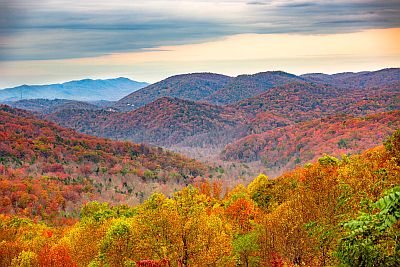Select units of measurement for the temperature and rainfall tables (metric or imperial).
Average weather, temperature, rainfall, sunshine hours
The Great Smoky Mountains National Park has a
humid temperate climate in the lower part, with quite cold winters and hot summers, while the higher part has cold, snowy winters and milder summers. Precipitation is abundant everywhere.
The park is located in the southeastern United States, between Tennessee and North Carolina, at 35 degrees north latitude.
It includes the Great Smoky Mountains and part of the Blue Ridge Mountains, which are in turn part of the
Appalachian Mountains.
The park has an area of 2,100 square kilometers (810 sqmi) and is currently the most visited in the United States. It features ancient forests, varied flora and fauna, mountain trails, lakes and waterfalls.
Because it is located on the crest of the mountains,
strong winds can sometimes blow, especially in the period from October to April.
 Winter
Winter, from December to February, is not very cold, since the daily average exceeds freezing, at least in the lower part, however, cold waves are possible, during which the temperature can drop below -20 °C (-4 °F). In the lower part it snows quite rarely, while on the mountain peaks, heavy snowfalls occur.
Spring, from March to May, is an unstable season. In the first part it can still be cold, while when temperatures rise,
afternoon thunderstorms begin to occur, which will then continue into summer.
Summer, from June to August, is hot and muggy, at least at low altitudes. Sometimes it can get very hot, especially in the lower part, where during heat waves the temperature can reach 38/40 °C (100/104 °F). There is no shortage of rain, in particular,
afternoon thunderstorms often occur.
Autumn, from September to November, is the least rainy season, and is less unstable than spring. At the end of September the first frosts can occur. In November it begins to snow on the mountain peaks.
Climate data
Let's start from the lower part of the park.
For the lower part, you can refer to data from
Gatlinburg, Tennessee, located 400 meters (1,300 feet) above sea level, near the north entrance of the park (Sugarlands). Here are the average temperatures.
Gatlinburg - Average temperatures|
| Month | Min | Max | Mean |
|---|
| January | -3.3 | 9.4 | 3.1 |
|---|
| February | -1.7 | 11.7 | 5 |
|---|
| March | 1.7 | 16.7 | 9.2 |
|---|
| April | 5.6 | 21.7 | 13.6 |
|---|
| May | 10.6 | 25 | 17.8 |
|---|
| June | 15 | 28.3 | 21.7 |
|---|
| July | 17.2 | 30 | 23.6 |
|---|
| August | 16.7 | 29.4 | 23.1 |
|---|
| September | 13.3 | 26.7 | 20 |
|---|
| October | 6.7 | 21.7 | 14.2 |
|---|
| November | 1.7 | 16.1 | 8.9 |
|---|
| December | -1.7 | 11.1 | 4.7 |
|---|
| Year | 6.9 | 20.7 | 13.75 |
|---|
Rainfall is abundant, as it is close to 1,500 mm (59 in) per year, and there is no dry season. In winter, it can sometimes snow. On average, 20 cm (8 in) of snow fall per year, distributed over six days, from December to March. Here is the average precipitation.
Gatlinburg - Average precipitation| Month | Days |
|---|
| January | 121 | 15 |
|---|
| February | 108 | 14 |
|---|
| March | 142 | 15 |
|---|
| April | 125 | 12 |
|---|
| May | 140 | 15 |
|---|
| June | 152 | 15 |
|---|
| July | 160 | 15 |
|---|
| August | 112 | 14 |
|---|
| September | 110 | 11 |
|---|
| October | 81 | 10 |
|---|
| November | 102 | 12 |
|---|
| December | 125 | 15 |
|---|
| Year | 1480 | 164 |
|---|

For the upper part, you can refer to Mount
Kuwohi (or Clingmans Dome), the highest peak in the park, at 2,025 meters (6,644 ft). The road to the summit is open from April 1 to November 30.
Kuwohi - Average temperatures|
| Month | Min | Max | Mean |
|---|
| January | -7.2 | 1.7 | -2.8 |
|---|
| February | -7.8 | 1.7 | -3.1 |
|---|
| March | -4.4 | 3.9 | -0.3 |
|---|
| April | 1.1 | 9.4 | 5.3 |
|---|
| May | 6.1 | 13.9 | 10 |
|---|
| June | 9.4 | 17.2 | 13.3 |
|---|
| July | 11.7 | 18.3 | 15 |
|---|
| August | 11.1 | 17.8 | 14.4 |
|---|
| September | 8.3 | 15.6 | 11.9 |
|---|
| October | 3.3 | 11.7 | 7.5 |
|---|
| November | -2.2 | 5.6 | 1.7 |
|---|
| December | -6.1 | 2.8 | -1.7 |
|---|
| Year | 2 | 10 | 6 |
|---|
Here, precipitation is even more abundant, since it amounts to 2,100 mm (82.7 in) per year. On average, 215 cm of snow fall per year. It can usually snow from October to April.
Kuwohi - Average precipitation| Month | Days |
|---|
| January | 178 | |
|---|
| February | 208 | |
|---|
| March | 208 | |
|---|
| April | 165 | |
|---|
| May | 152 | |
|---|
| June | 175 | |
|---|
| July | 211 | |
|---|
| August | 173 | |
|---|
| September | 130 | |
|---|
| October | 137 | |
|---|
| November | 163 | |
|---|
| December | 185 | |
|---|
| Year | 2085 | |
|---|
Most of the park is at an intermediate altitude, so it has temperatures and rainfall halfway between these two extremes.